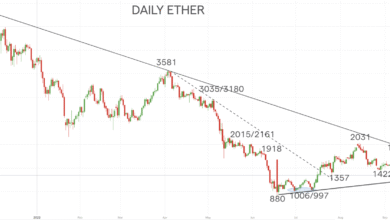Bitcoin Price Analysis: Short-Term Downtrend Unfolds
In the ever-evolving world of cryptocurrencies, Bitcoin price analysis plays a crucial role in understanding market dynamics and guiding investment decisions. As Bitcoin experiences fluctuations between notable price levels, traders and investors closely monitor Bitcoin support and resistance to identify critical thresholds. Currently, the cryptocurrency market trends indicate a bearish outlook, especially following recent sell-offs that highlight Bitcoin’s volatility analysis. The ongoing bearish trend has raised concerns among investors, yet discerning Bitcoin price predictions can reveal potential opportunities hidden within this volatility. By dissecting these market patterns, stakeholders can navigate the unpredictability of Bitcoin’s price, ultimately positioning themselves for future growth.
When examining the fluctuations of Bitcoin, a careful evaluation of its price movements becomes essential for both traders and long-term investors alike. This cryptocurrency, often synonymous with digital gold, showcases various trends that can dictate investment strategies, making effective market analysis vital. As we delve deeper into the current state of Bitcoin, we uncover significant support levels and resistance points that inform our next steps. The observed bearish sentiment in recent weeks prompts a re-assessment of Bitcoin’s potential trajectory, illuminating the need for astute price predictions. Through this exploration, we aim to decipher the intricacies of Bitcoin’s price behavior and its implications for the broader cryptocurrency landscape.
Bitcoin Price Analysis: Understanding the Current Market Dynamics
In recent days, Bitcoin has exhibited a notable short-term bearish trend, particularly after it peaked at $96,620. This downtrend is characterized by a series of lower highs and lower lows, leading to increased market skepticism about the cryptocurrency’s immediate future. With trading volume logged at $19.74 billion and significant movements between the ranges of $93,806 to $95,741, it is crucial to analyze the implications using support and resistance levels.”},{
Examining the Impact of Bitcoin Support and Resistance Levels
Support and resistance levels are pivotal in determining Bitcoin’s price movements. Currently, support is evident at $93,000 to $94,000, suggesting a critical area where buying interest may sustain prices against further declines. If Bitcoin successfully holds this zone, it may signal exhaustion in the recent bearish momentum, thereby enabling a retest of resistance levels at $96,500 to $97,000.
Conversely, if Bitcoin breaches the support at $92,846, it could trigger escalated selling pressure, forcing prices down towards the $90,000 mark. Understanding these thresholds can provide traders with insights into potential entry or exit points, heightening their strategy in responding to Bitcoin’s volatility.
Frequently Asked Questions
What are the key factors influencing Bitcoin price analysis today?
Current Bitcoin price analysis highlights several key factors, including market capitalization of **$1.86 trillion**, a recent price range of **$93,806** to **$95,741**, and significant trading volume. Trends indicate a series of lower highs and lows, suggesting a bearish trend after hitting a peak at **$96,620**.
How do Bitcoin price predictions reflect market trends for the upcoming days?
Bitcoin price predictions are influenced by recent bearish patterns and critical support levels such as **$92,846**. If Bitcoin can reclaim the **$95,000** level, it may signal a bullish reversal, potentially validating a near-term uptrend after weeks of downtrend.
What is the importance of support and resistance in Bitcoin price analysis?
In Bitcoin price analysis, support and resistance levels are critical for forecasting potential price movements. Support at **$93,000–94,000** must hold to avert deeper retracement, while resistance between **$96,500** and **$97,000** hinders bullish momentum, indicating points where traders might enter or exit positions.
How does Bitcoin’s volatility impact its price analysis?
Bitcoin’s volatility significantly impacts its price analysis by affecting the reliability of trends and breakout signals. The recent volatility analysis indicates a bearish structure, as the price continually failed to sustain levels above **$96,000** while exhibiting selling pressure at lower trading ranges.
What role does the bearish trend play in Bitcoin price analysis?
The ongoing bearish trend in Bitcoin price analysis showcases a series of declining peaks and troughs, indicating weaker buyer interest. This trend is characterized by heightened volatility and significant sell volumes around critical support levels, reinforcing concerns of a deeper downtrend if key price points are breached.
Why is market sentiment critical in Bitcoin price analysis?
Market sentiment is fundamental in Bitcoin price analysis as it drives trading behaviors and influences volatility. The recent bearish sentiment, indicated by substantial sell-offs and resistance at crucial levels, signals a cautious outlook for traders, suggesting potential declines unless bullish momentum returns.
How can traders interpret Bitcoin price analysis to make informed decisions?
Traders can use Bitcoin price analysis by closely monitoring support and resistance levels, volume trends, and momentum indicators. Observing whether Bitcoin maintains critical supports over **$93,000** or breaches levels like **$92,846** will guide trading strategies and risk management decisions effectively.
What does Bitcoin volatility analysis suggest for future price movements?
Bitcoin volatility analysis suggests future price movements may remain uncertain unless the market stabilizes above the **$95,000** mark. Increased volatility often results from trader reactions to market sentiment, impacting short-term price predictions and potential corrections.
How can Bitcoin price analysis assist in understanding market corrections?
Bitcoin price analysis helps identify trends that precede market corrections by highlighting patterns of lower highs and lows, alongside critical volume spikes. A breakdown below key supports could signal deeper corrections, while maintaining support may suggest accumulation phases leading to rebound.
What can we expect from Bitcoin in the coming weeks based on its price analysis?
Based on current price analysis, if Bitcoin manages to hold above the **$93,000–$94,000** support and recoups **$95,000** on strong volumes, we could expect a potential rally towards the **$96,500–$97,000** resistance zone. Conversely, breaching lower supports may lead to further declines.
| Key Indicator | Value | Analysis |
|---|---|---|
| Current Price Range | $94,089 – $94,305 | Indicates trading in a tight range, typical of indecision. |
| Market Capitalization | $1.86 trillion | Strengthens Bitcoin’s position as a leading asset. |
| Daily Trade Volume | $19.74 billion | Strong activity suggests high interest and liquidity. |
| 24-hour Price Range | $93,806 – $95,741 | Reflects volatility and current bearish trend. |
| Critical Support Level | $92,846 | Break below this level may trigger further declines. |
| Resistance Levels | $96,500 – $97,000 | Resistance zone has consistently pushed back bullish moves. |
| Momentum Indicators | RSI: 60, Stochastic: 74, CCI: 42 | Mostly neutral but leaning bearish indicates potential exhaustion. |
Summary
Bitcoin price analysis indicates a period of correction as the market struggles with bearish signals. The ongoing downtrend suggests that unless Bitcoin can reclaim key levels around $95,000, a potential decline towards $91,000 could be imminent. Observing the market’s behavior around critical support zones will be essential for understanding future movements.




